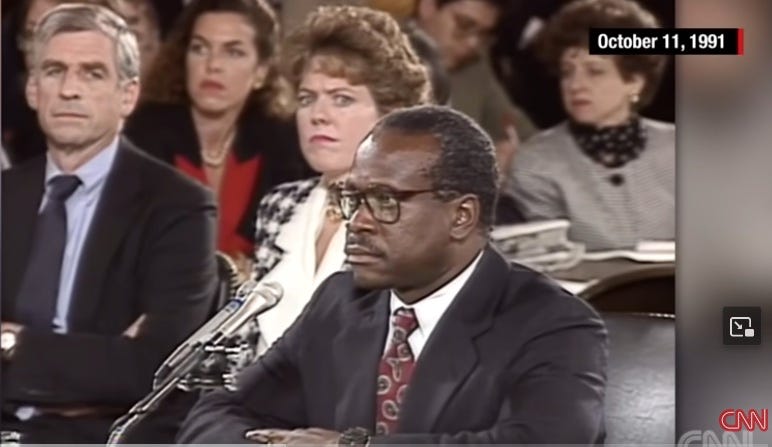A Bloomsday postcard, and the thirty year cycle of shame with Clarence Thomas and his enablers
May 7, 2023
Shooting stars against a backdrop of bursting balsamroot blossoms
Like most of you who were alive at the time, I remember where I was the day JFK was assassinated in Dallas in late November 1963. I was six years old and, with little legs, was walking in Panamanian warmth from Los Rios Elementary School in the U.S. Canal Zone to our home in nearby Corozal. A kind woman in a sedan saw me walking alone and pulled over to give me a ride the rest of the way. I noticed she had tears in her eyes. She told me what had happened to the President. I brought that news home to my mother. You can imagine the rest.
I also remember where I was on October 11, 1991. My wife and I had just moved from Augusta, GA to Spokane. I worked at home in Browne’s Addition and was easily sucked into the high drama of the Clarence Thomas confirmation hearings being carried live by CNN. I had watched Anita Hill’s testimony; watched her tell her story about the sexual harassment she said she’d experienced working as an aide to Thomas. Her bravery and poise were self-evident. And now it was Thomas’s turn to respond. With umbrage that could boil water in a hot tub he protested that he was being subjected to a “high-tech lynching.”
Clarence Thomas, flanked by Sen. John Danforth and Thomas’s wife Ginni at his 1991 confirmation hearing.
It was nauseating on several levels. The first was the bare-knuckled cynicism of George H.W. Bush appointing a conservative African-American to replace the legendary civil rights advocate Thurgood Marshall on the Supreme Court. (Justice Marshall had retired, in ill health, and would pass away two years later). There was nothing in Thomas’s career to indicate he would champion civil rights, let alone support their expansion to address civil injustice toward women and people of color. But here he was, brazenly playing the race card in response to Hill’s allegations.
What was even more disgusting was how the all-male Senate panel, chaired by then Sen. Joe Biden, treated Hill.
A decade earlier I had done a story, as a young police reporter, about the appalling practice of the police in the Yakima valley subjecting rape victims to polygraph exams. This felt like that, only worse.
Biden was terrible. It was on his watch that a woman, Sukari Hardnett, who would have corroborated Hill’s accounts, was not called to testify. It seemed Biden was much more interested in preserving the bipartisan comity of his Senate peers than in examining Thomas’s fitness for the Supreme Court. The deck was stacked in that way, with Thomas’s wife Ginni sitting behind him, and next to her the highly-respected Senator John (“Jack”) Danforth of Missouri, Thomas’s mentor. The lasting impression is that Anita Hill was disposable, because that’s how she was treated.
Against that history, it’s noteworthy what we’ve learned about Justice Thomas and his wife, just in past few weeks. I’ll get to the details shortly. But the sense many of us had 32 years ago is that something really important about us and our politics was being hastily buried, to hide the evidence, not just to hide the truth but to intimidate those who would dare speak truth to power.
When I last wrote about what was coming to light about Clarence and Ginni Thomas it was a month ago, when ProPublica published it’s stunning report about the unreported gifts of exotic vacations that a billionaire Texas businessman, Harlan Crow, had bestowed upon the Thomases. Since then, there’ve been the following revelations:
•On April 13th, ProPublica added to the story by reporting that Crow, in 2014, had paid Thomas and other members of his family more than $130,000 for the home of Thomas’s mother, and other properties owned by Thomas. Crow also paid for major modifications to the Thomas home and, moreover, allowed Thomas’s mother to continue living there rent free. As with nearly all the luxury travel Crow had provided the Thomases, none of this was disclosed pursuant to applicable ethical standards.
•On May 4th, ProPublica reported that Crow had also paid approximately $60,000 in private school tuition and other expenses for Thomas’s grand-nephew during the time Thomas was serving as his legal guardian. Thomas failed to disclose this as well.
•The same day (5/4), the Washington Post reported the story that seems to lash the whole mess of conflicts together. The headline read “Judicial activist directed fees to Clarence Thomas’s wife, urged ‘no mention of Ginni’.”
The “activist” referenced in the WaPo headline is Leonard Leo—the same Leonard Leo who was sitting alongside Thomas and his billionaire Texan backer Harlan Crow in the memorable painting that ProPublica featured in its first story. This was/is the image of Thomas and Crow sitting together, smoking cigars, at the billionaire’s Adirondack retreat.
In short, Leonard Leo is the legendary conservative Republican organizer and fundraiser behind the Federalist Society—the super-lobby that screens judicial candidates for federal court appointments, and then passes the names onto Republican presidents. It’s all part of a longstanding plan to impose a right-wing vision of America by having a conservative court majority put its stamp not just on the legal system but, by extension, state legislatures. It is Leo’s work, more than any other single person’s, that built the majority on the Supreme Court to repeal Roe v. Wade. As I noted in my April 11th piece, Thomas once referred to Leo as the 3rd most powerful man on the planet, even though Leo has never held a government position.
The nugget of the WaPo’s May 4th exposé was the news that Leo—using his legendary influence—directed Kellyanne Conway (yes, the same Kellyanne Conway who would emerge as the top spokeswoman for President Trump) to funnel money to Ginni Thomas for her political work.
Here’s the key paragraphs from the story—the facts in which are not in dispute.
In January 2012, Leo instructed the GOP pollster Kellyanne Conway to bill a nonprofit group he advises and use that money to pay Virginia “Ginni” Thomas, the documents show. The same year, the nonprofit, the Judicial Education Project, filed a brief to the Supreme Court in a landmark voting rights case.
Leo, a key figure in a network of nonprofits that has worked to support the nominations of conservative judges, told Conway that he wanted her to “give” Ginni Thomas “another $25K,” the documents show. He emphasized that the paperwork should have “No mention of Ginni, of course.”
When asked to explain why there should be “No mention of Ginni, of course,” Leo told the Post: “Knowing how disrespectful, malicious and gossipy people can be, I have always tried to protect the privacy of Justice Thomas and Ginni.”
This is where the whole rotten story of the Thomases comes full circle.
The money Leo and Conway worked together to pay Ginni Thomas came from the Judicial Education Project—an entity which, as the saying goes, has “business before the court”—meaning they openly advocate for judicial decisions that further its interests and causes. Among the causes JEP directly advocated in filings with the U.S. Supreme Court was for major changes to the Federal Voting Rights Act of 1965 that would strip the U.S. Justice Department of its so-called “pre-clearance” role in overseeing voting laws and practices in states with a history of racial discrimination in managing elections.
That effort succeeded in 2013. With Justice Thomas in the majority, the Supreme Court issued a decision in Shelby County [Alabama] v. Holder, effectively eliminating the Justice Department’s “pre-clearance” role. According to the Brennan Center for Justice: “The effects were immediate. Within 24 hours of the ruling, Texas announced that it would implement a strict photo ID law. Two other states, Mississippi and Alabama, also began to enforce photo ID laws that had previously been barred because of federal pre-clearance.”
The lame excuses that Harlan Crow is just a close friend with no business or interest in the Supreme Court, or that Ginni Thomas’s partisan political work and the income she derives from it has no effect on her husband are insulting. Moreover, the word “partisan” is far too mild. The record shows Ginni Thomas had direct access to the Trump White House through chief of staff Mark Meadows to whom she vehemently pushed her utterly baseless and discredited claims that the 2020 election was rigged in Biden’s favor.
For the flavor of these exchanges, here is one of 29 we know of, as reported by Bob Woodward and Robert Costa of the Washington Post: “Help This Great President stand firm, Mark!!!...You are the leader, with him, who is standing for America’s constitutional governance at the precipice. The majority knows Biden and the Left is attempting the greatest Heist of our History.”
Trump sought the Supreme Court’s intervention and when the Court declined to do so, Justice Thomas dissented, casting the majority’s decision as “inexplicable.”
There are other reasons for the Supreme Court’s plunge in public approval and confidence. But the recent bombshells about the behavior and arrogance of both the Thomases and their enablers is likely to send the court’s credibility even further into the abyss.
It doesn’t take a lawyer to understand the ethical lapses in Thomas’s behavior, some of which may implicate criminal exposure. Thomas should clearly have recused himself and there’s no question he failed to disclose not just the lavish financial favors extended to him by Crow, but the payments his wife received through the favors of Leonard Leo—someone whose entire reputation is built upon his successful efforts to re-shape the U.S. justice system, from the Supreme Court on down.
The Thomas story, from day one, going back three decades, is a vivid and ongoing chapter in the pursuit of raw power. It is power being used for power’s sake—to secure ever more power at the expense of what should be our common democratic aspirations, including the still noble and vital goal to extend civil rights and equal protection under law to African-Americans and other minority groups.
—tjc






